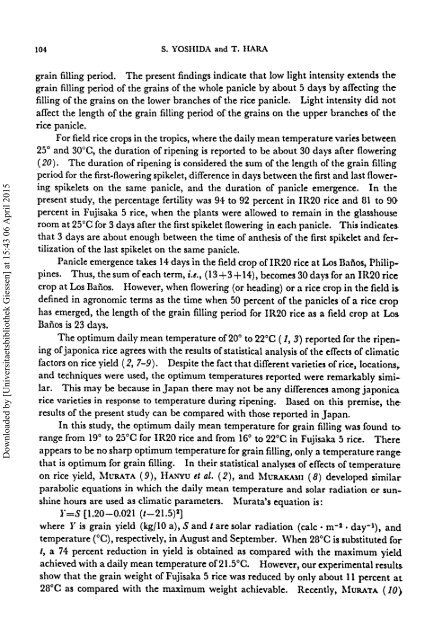Yoshida und Hara - 1977 - Effects of air temperature and light on grain fill
Yoshida und Hara - 1977 - Effects of air temperature and light on grain fill
Yoshida und Hara - 1977 - Effects of air temperature and light on grain fill
Create successful ePaper yourself
Turn your PDF publications into a flip-book with our unique Google optimized e-Paper software.
104 S. YOSHIDA <str<strong>on</strong>g>and</str<strong>on</strong>g> T. HARA<br />
Downloaded by [Universitaetsbibliothek Giessen] at 15:43 06 April 2015<br />
<strong>grain</strong> <strong>fill</strong>ing period. The present findings indicate that low <str<strong>on</strong>g>light</str<strong>on</strong>g> intensity extends the<br />
<strong>grain</strong> <strong>fill</strong>ing period <str<strong>on</strong>g>of</str<strong>on</strong>g> the <strong>grain</strong>s <str<strong>on</strong>g>of</str<strong>on</strong>g> the whole panicle by about 5 days by affecting the<br />
<strong>fill</strong>ing <str<strong>on</strong>g>of</str<strong>on</strong>g> the <strong>grain</strong>s <strong>on</strong> the lower branches <str<strong>on</strong>g>of</str<strong>on</strong>g> the rice panicle. Light intensity did not<br />
affect the length <str<strong>on</strong>g>of</str<strong>on</strong>g> the <strong>grain</strong> <strong>fill</strong>ing period <str<strong>on</strong>g>of</str<strong>on</strong>g> the <strong>grain</strong>s <strong>on</strong> the upper branches <str<strong>on</strong>g>of</str<strong>on</strong>g> the<br />
rice panicle.<br />
For field rice crops in the tropics, where the daily mean <str<strong>on</strong>g>temperature</str<strong>on</strong>g> varies between<br />
25° <str<strong>on</strong>g>and</str<strong>on</strong>g> 30°C, the durati<strong>on</strong> <str<strong>on</strong>g>of</str<strong>on</strong>g> ripening is reported to be about 30 days after flowering<br />
(20). The durati<strong>on</strong> <str<strong>on</strong>g>of</str<strong>on</strong>g> ripening is c<strong>on</strong>sidered the sum <str<strong>on</strong>g>of</str<strong>on</strong>g> the length <str<strong>on</strong>g>of</str<strong>on</strong>g> the <strong>grain</strong> <strong>fill</strong>ing<br />
period for the first-flowering spikelet, difference in days between the first <str<strong>on</strong>g>and</str<strong>on</strong>g> last flowering<br />
spikelets <strong>on</strong> the same panicle, <str<strong>on</strong>g>and</str<strong>on</strong>g> the durati<strong>on</strong> <str<strong>on</strong>g>of</str<strong>on</strong>g> panicle emergence. In the<br />
present study, the percentage fertility was 94 to 92 percent in IR20 rice <str<strong>on</strong>g>and</str<strong>on</strong>g> 81 to 9(}<br />
percent in Fujisaka 5 rice, when the plants were allowed to remain in the glasshouse<br />
room at 25°C for 3 days after the first spikelet flowering in each panicle. This indicates.<br />
that 3 days are about enough between the time <str<strong>on</strong>g>of</str<strong>on</strong>g> anthesis <str<strong>on</strong>g>of</str<strong>on</strong>g> the first spikelet <str<strong>on</strong>g>and</str<strong>on</strong>g> fertilizati<strong>on</strong><br />
<str<strong>on</strong>g>of</str<strong>on</strong>g> the last spikelet <strong>on</strong> the same panicle.<br />
Panicle emergence takes 14 days in the field crop <str<strong>on</strong>g>of</str<strong>on</strong>g>IR20 rice at Los Banos, Philippines.<br />
Thus, the sum <str<strong>on</strong>g>of</str<strong>on</strong>g> each term, i.e., (13+3+14), becomes 30 days for an IR20 rice<br />
crop at Los Banos. However, when flowering (or heading) or a rice crop in the field is.<br />
defined in agr<strong>on</strong>omic terms as the time when 50 percent <str<strong>on</strong>g>of</str<strong>on</strong>g> the panicles <str<strong>on</strong>g>of</str<strong>on</strong>g> a rice crop<br />
has emerged, the length <str<strong>on</strong>g>of</str<strong>on</strong>g> the <strong>grain</strong> <strong>fill</strong>ing period for IR20 rice as a field crop at Los.<br />
Banos is 23 days.<br />
The optimum daily mean <str<strong>on</strong>g>temperature</str<strong>on</strong>g> <str<strong>on</strong>g>of</str<strong>on</strong>g> 20° to 22°C (J, 3) reported for the ripening<br />
<str<strong>on</strong>g>of</str<strong>on</strong>g> jap<strong>on</strong>ica rice agrees with the results <str<strong>on</strong>g>of</str<strong>on</strong>g> statistical analysis <str<strong>on</strong>g>of</str<strong>on</strong>g> the effects <str<strong>on</strong>g>of</str<strong>on</strong>g> climatic<br />
factors <strong>on</strong> rice yield (2, 7-9). Despite the fact that different varieties <str<strong>on</strong>g>of</str<strong>on</strong>g> rice, locati<strong>on</strong>s~<br />
<str<strong>on</strong>g>and</str<strong>on</strong>g> techniques were used, the optimum <str<strong>on</strong>g>temperature</str<strong>on</strong>g>s reported were remarkably similar.<br />
This may be because in Japan there may not be any differences am<strong>on</strong>g jap<strong>on</strong>ica<br />
rice varieties in resp<strong>on</strong>se to <str<strong>on</strong>g>temperature</str<strong>on</strong>g> during ripening. Based <strong>on</strong> this premise, the<br />
results <str<strong>on</strong>g>of</str<strong>on</strong>g> the present study can be compared with those reported in Japan.<br />
In this study, the optimum daily mean <str<strong>on</strong>g>temperature</str<strong>on</strong>g> for <strong>grain</strong> <strong>fill</strong>ing was fo<str<strong>on</strong>g>und</str<strong>on</strong>g> torange<br />
from 19° to 25°C for IR20 rice <str<strong>on</strong>g>and</str<strong>on</strong>g> from 16° to 22°C in Fujisaka 5 rice. There<br />
appears to be no sharp optimum <str<strong>on</strong>g>temperature</str<strong>on</strong>g> for <strong>grain</strong> <strong>fill</strong>ing, <strong>on</strong>ly a <str<strong>on</strong>g>temperature</str<strong>on</strong>g> range<br />
that is optimum for <strong>grain</strong> <strong>fill</strong>ing. In their statistical analyses <str<strong>on</strong>g>of</str<strong>on</strong>g> effects <str<strong>on</strong>g>of</str<strong>on</strong>g> <str<strong>on</strong>g>temperature</str<strong>on</strong>g><br />
<strong>on</strong> rice yield, MURATA (9), HANYU et al. (2), <str<strong>on</strong>g>and</str<strong>on</strong>g> MURAKAMI (8) developed similar<br />
parabolic equati<strong>on</strong>s in which the daily mean <str<strong>on</strong>g>temperature</str<strong>on</strong>g> <str<strong>on</strong>g>and</str<strong>on</strong>g> solar radiati<strong>on</strong> or sunshine<br />
hours are used as climatic parameters. :Murata's equati<strong>on</strong> is:<br />
r =s [1.20-0.021 (t-21.5)2]<br />
where Y is <strong>grain</strong> yield (kg/lO a), S<str<strong>on</strong>g>and</str<strong>on</strong>g> t are solar radiati<strong>on</strong> (calc· m- 2 • day-I), <str<strong>on</strong>g>and</str<strong>on</strong>g><br />
<str<strong>on</strong>g>temperature</str<strong>on</strong>g> (0C), respectively, in August <str<strong>on</strong>g>and</str<strong>on</strong>g> September. When 2BoC is substituted for<br />
t, a 74 percent reducti<strong>on</strong> in yield is obtained as compared with the maximum yield<br />
achieved with a daily mean <str<strong>on</strong>g>temperature</str<strong>on</strong>g> <str<strong>on</strong>g>of</str<strong>on</strong>g>21.5°C. However, our experimental results.<br />
show that the <strong>grain</strong> weight <str<strong>on</strong>g>of</str<strong>on</strong>g> Fujisaka 5 rice was reduced by <strong>on</strong>ly about 11 percent at<br />
28°C as compared with the maximum weight achievable. Recently, MURATA (JO}
















